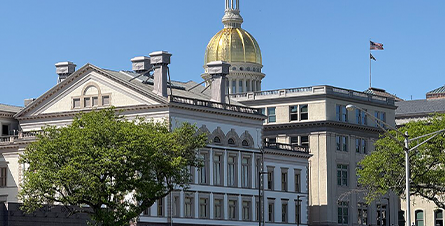PFAS Water Settlements: 3 Steps to Take Now if Your System Opted Out
2.12.24
The impact of water pollution due to PFAS (per- and polyfluoroalkyl substances) has been a topic of increasing concern in recent years for public drinking water providers throughout the United States. Associated with numerous negative effects to human health and impossible to remove through traditional treatment processes, these contaminants are resulting in new challenges for many water systems. As municipalities and utilities seek solutions to PFAS contamination, many are finding that the cost of managing these pollutants will far exceed their available financial resources.
Many water systems are currently seeking to relieve this financial burden through participation in the PFAS settlements proposed by manufacturers 3M and DuPont. While these multibillion-dollar agreements are an important step toward protecting the public from dangerous drinking water contaminants, some utilities decided that participation was not the best option for them. If your system opted out of the settlements before the 2023 deadlines, it is vital to evaluate your unique situation and take the appropriate steps to recover PFAS cleanup costs incurred now or in the future. Should such systems choose to remain opted out of the settlements, litigation will now be the only avenue to recover costs from 3M and DuPont.
In this blog, we will discuss the status of the proposed PFAS water settlements and important details to consider if your system has opted out of the agreements. Then, we will list three key steps that you can take now to seek the best outcome for your community.
Understanding the PFAS Water Settlements
PFAS are a group of synthetic chemicals that have been used in a variety of consumer products, firefighting foams, and industrial applications for over 50 years. Their strong resistance to biodegradation has earned them the nickname "forever chemicals." For decades, manufacturers failed to warn consumers and the United States government of the public health risks associated with PFAS exposure, which include certain cancers, thyroid disorders, ulcerative colitis, infertility, and more. Widespread use of PFAS has resulted in extensive contamination of drinking water sources throughout the country. Advanced treatment technologies are capable of removing and even destroying these contaminants, however, they come at a high cost to utilities and the communities they serve.
Faced with the unexpected costs of treatment, many systems have filed lawsuits against PFAS manufacturers, seeking to hold the companies responsible for water pollution. These lawsuits have been grouped into the Aqueous Film-Forming Foam (AFFF) Multi-District Litigation (MDL) that eventually led to the proposed PFAS class action settlements.
What Public Water Providers Need to Know About the AFFF MDL
The AFFF MDL is a consolidated legal process in which multiple lawsuits filed by public water providers, property owners, personal injury plaintiffs, and sovereigns (such as states, territories, and tribes) from across the country have been grouped together. All of these lawsuits claim that the plaintiffs have been negatively impacted by contamination stemming from the use of AFFF, a PFAS-containing firefighting foam, as well as other PFAS products. In an effort to resolve some of these legal claims, DuPont and its related companies, Chemours and Corteva, offered U.S. public water providers a settlement totaling $1.1859 billion in June 2023. Shortly after the DuPont settlement was announced, 3M agreed to pay U.S. public water providers up to $12.5 billion over 13 years in settlement funds.
It is important to note that, although the settlements were proposed as a result of the AFFF MDL, they apply to all public water providers, regardless of whether they have filed a lawsuit or are part of the MDL. This means that even if a water system did not file a claim in the MDL, they are still subject to the settlements and may be eligible to receive compensation if they complete the appropriate forms and paperwork by the proper deadlines.
Current Status of the PFAS Settlements
The DuPont settlement recently received final approval from the court, and the 3M settlement is similarly expected to be accepted by the court. Under both the 3M and DuPont agreements, all eligible public water systems are included unless they opted out. The opt-out deadline for the DuPont settlement was December 4th, 2023, while the opt-out deadline for the 3M settlement was December 11th, 2023. The systems that did not opt out of the settlements should now be gathering information and completing claims forms. It is crucial for participating systems to pay close attention to upcoming submission deadlines and prepare any necessary data. If they fail to do so, they will likely miss their opportunity to be awarded any compensation from 3M and DuPont, as they will have failed to properly submit claims under the settlements. Their participation in the settlements also makes them ineligible to file future lawsuits against 3M and DuPont over PFAS contamination of drinking water.
Has Your Water System Opted Out?
Because these are “opt out” settlements, water systems wishing not to participate in them had to affirmatively complete and submit the necessary paperwork by the above opt out deadlines. If your system did not submit such a request for exclusion from the PFAS water settlements in a timely manner, then it is a participant by default. When determining your status, it is important to note that it is possible to be a participant in one settlement but not the other, as the DuPont and 3M settlements are separate and distinct. Thus, if your system did not wish to participate in either settlement, it needed to opt out of both. Once you have determined your participation status for each settlement, you can plan your next steps.
3 Steps to Take Now if Your System Opted Out
If your water system has opted out of the PFAS settlements, the path to cost recovery does not end here. On the contrary, acting now can help you avoid missing out on other opportunities to seek funds to protect your community's water quality. The following three steps provide a roadmap for systems that have opted out.
Step 1: Verify That Your Opt-Out was Accepted
The first step for water providers that have tried to opt out of one or both settlements is to verify their opt-out was accepted by the Notice Administrator. The Notice Administrator for the proposed DuPont settlement initially determined that hundreds of systems' attempts to opt out were invalid for various deficiencies such as missed deadlines and incorrect filing procedures. The Court has since provided additional guidance suggesting that some of those attempted opt-outs may be valid and directed the Notice Administrator to reexamine them for accuracy, which led to more attempted opt outs being accepted by the Notice Administrator. That said, if your system intended to opt out of either settlement, you will want to first confirm with the Notice Administrator that your request for exclusion was sufficient and accepted. The Notice Administrator encourages water providers to reach out by phone at 855-972-9592.
Step 2: Confirm Opting Out is the Right Choice for Your System
Once you have confirmed that your system was successful in opting out of the settlements, the next step is to confirm if opting out was truly the best choice for it. To allow eligible systems additional time to reconsider their decisions, the court extended the deadline of March 1st, 2024, for water providers to withdraw their requests for exclusion from both the 3M and DuPont settlements. It is important to note that this deadline only applies to systems that have already submitted paperwork to opt out of either settlement. If you missed the settlement opt-out deadlines in December 2023, it is too late to opt out now.
When considering whether to opt back into either or both settlements, it is vital to have updated PFAS testing data available. Although the exact payout amounts cannot be guaranteed, the estimated allocation ranges are based on each water source's detected PFAS concentrations and adjusted flow rates. If your system has not yet conducted thorough testing for PFAS in all applicable water sources, it is essential to do so to best estimate the funds you are forfeiting by opting out. Each system's situation and contamination challenges are unique, and many individual factors will influence your choice. With this in mind, it is advisable to seek legal counsel from a firm experienced in water contamination litigation to help make an informed decision.
Step 3: Consider Cost Recovery for Current or Future PFAS Contamination
If you have carefully evaluated your options and determined that opting out of the proposed PFAS settlements was indeed the best choice for your system, then now is the time to begin exploring alternative avenues for cost recovery. This is especially true if your PFAS situation changes in the future to require more treatment than initially anticipated.
Even if testing has shown that PFAS are not yet present in your water supplies, or that the concentrations are very low, it is wise to plan for potential future management needs. Due to their persistence in the environment, PFAS chemicals tend to build up over time, sometimes resulting in higher concentrations in drinking water supplies. At the same time, state and federal regulations are subject to change and may become more stringent in later years. By taking steps to recover funds, your system will be better prepared to manage the cost associated with future contamination concerns.
If your system has opted out of the settlements, the only way to recover funds from 3M and DuPont will be through litigation. Many water and wastewater systems have already filed lawsuits, and others are likely to do so in the coming months. There are several important points to keep in mind when considering litigation, outlined below.
Is Litigation an Option if PFAS Detections are Below the EPA’s Proposed Regulations?
Currently, the Environmental Protection Agency (EPA) is expected to finalize its proposed maximum contaminant levels (MCLs) for six different PFAS chemicals in the first half of 2024. While these new regulations will likely increase the pressure on U.S. drinking water providers to implement PFAS treatment technologies, it is not necessary to have PFAS detections above the proposed MCLs to recover funds from manufacturers such as 3M and DuPont.
Litigation is still an option for systems that have detected any level of PFAS in their drinking water supplies. Water providers can file claims even if their PFAS detections are well below current state standards or proposed national MCLs. Many utilities have, in fact, successfully pursued this strategy over the years for a variety of contaminants that affected their water supplies.
Why is it Important to Take Action Now?
When considering litigation as an option to recover funding for PFAS treatment, it is important to act quickly. Water contamination lawsuits are subject to statutes of limitations that define the timeframe within which your system must act, usually from the time of detection to filing of a lawsuit.
In some cases, this may mean that time is already running out for your system to file a claim. Claims brought after the statutes of limitations have run out cannot be brought to court, no matter how valid or valuable they are. Therefore, it is important to begin exploring your options for legal action as soon as possible.
Get Personalized Advice for Your Water System
Many factors will determine the best path to cost recovery for systems that have opted out of the PFAS settlements proposed by DuPont and 3M. Because of this, it is helpful to seek the guidance of a legal team with extensive experience in water contamination litigation. Water systems that have opted out will need to carefully weigh their options, and not all firms are willing to represent them due to the complexity of such cases and the individualized attention they will require.
The attorneys at SL Environmental Law Group are available to help guide systems through the legal process after opting out of the proposed settlements. SL currently represents about 200 clients in the ongoing PFAS MDL, seeking to help each one recover cleanup costs and hold manufacturers accountable for contamination. To learn more about your PFAS litigation options, schedule a free consultation with our legal team today.



